Emperor Penguin
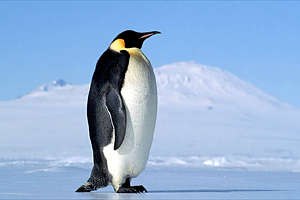

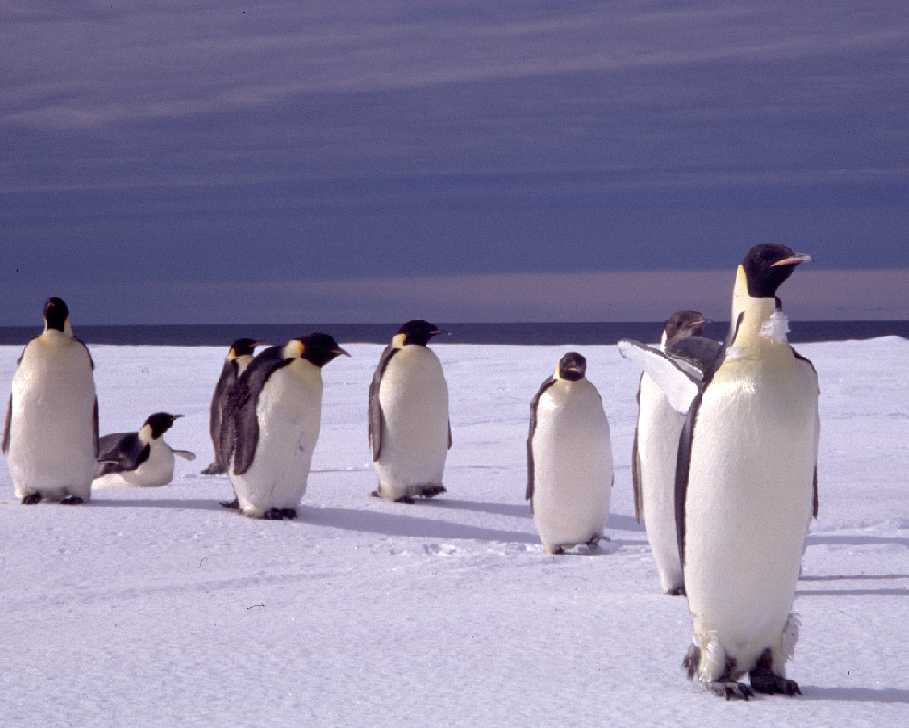 While most penguin species mate in the summer, Emperors breed during the winter months and the female will lay one egg around June. The female then leaves the eggs for the male to care for while she fattens up on fresh fish, not returning for about 9 weeks. Crowded together for warmth, the males use their webbed feet to keep the eggs off the ice (instead of a nest) and a flap rests on the egg keeping it warm - brooding, or huddling together, until their female returns, right before the chicks hatch. If the female is late in returning and the chicks have already hatched, the male will produce a curd-like substance and actually feed the chicks until the female returns! By the time the now fat female returns, the male may have lost from a third to half of his own weight. Not to be outdone by his female mate, the male leaves the female to care for the newly hatched chicks for another three to six weeks while he fishes for a variety of fish, squid and krill. Then the male returns and they jointly care for their chick until the chick can search for food on its own in the water, around eight weeks and typically in the month of December.
While most penguin species mate in the summer, Emperors breed during the winter months and the female will lay one egg around June. The female then leaves the eggs for the male to care for while she fattens up on fresh fish, not returning for about 9 weeks. Crowded together for warmth, the males use their webbed feet to keep the eggs off the ice (instead of a nest) and a flap rests on the egg keeping it warm - brooding, or huddling together, until their female returns, right before the chicks hatch. If the female is late in returning and the chicks have already hatched, the male will produce a curd-like substance and actually feed the chicks until the female returns! By the time the now fat female returns, the male may have lost from a third to half of his own weight. Not to be outdone by his female mate, the male leaves the female to care for the newly hatched chicks for another three to six weeks while he fishes for a variety of fish, squid and krill. Then the male returns and they jointly care for their chick until the chick can search for food on its own in the water, around eight weeks and typically in the month of December.
Emperor Penguins rely on the sounds their chicks make to distinguish their chicks from anothers chicks. Many Emperors gather their chicks together in day care centers called creches.
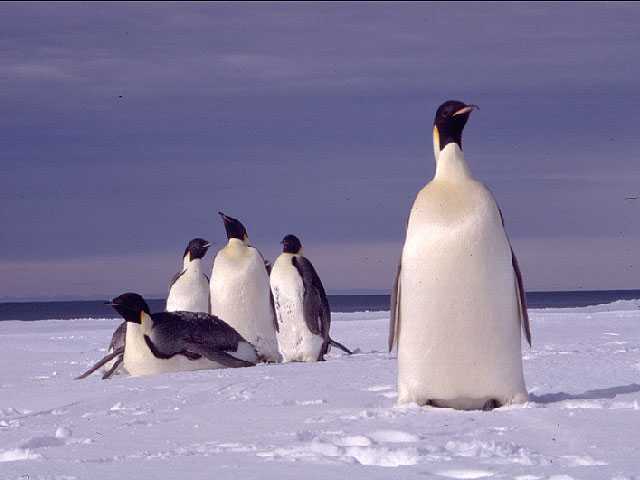 Emperor penguins are the largest of the 17 penguin species. Emperor penguins can be 3 to 4 feet tall. They can weigh anywhere from 65 to 90 lb. They can dive to depths of 900 feet (about 300 meters), staying under water for minutes on end. Dives to depths of 1750 feet and as long as 18 minutes have been recorded for the Emperor Penguin. Penguins can not fly, like other bird species. They can only swim with flippers which are modified wings about a foot long that are specifically meant for swimming. These flippers help them travel at speeds of up to 15 miles per hour. They do not have feathers like normal birds either; instead they have scaly feathers to better aid in swimming and which are water resistant so they do not get cold in the freezing Antartic waters. Their body is very streamlined so they can efficiently glide through the water with little resistance, helping swim faster and easier. Their feet are like shaped like paddles, making swimming much easier for them. To further aid them in warmth, Emperor Penguins have a coat of blubber around them, keeping them very warm. Their feathers are also tightly packed using a coating of oil to keep them warm by preventing water from coming in contact with their bodies.
Emperor penguins are the largest of the 17 penguin species. Emperor penguins can be 3 to 4 feet tall. They can weigh anywhere from 65 to 90 lb. They can dive to depths of 900 feet (about 300 meters), staying under water for minutes on end. Dives to depths of 1750 feet and as long as 18 minutes have been recorded for the Emperor Penguin. Penguins can not fly, like other bird species. They can only swim with flippers which are modified wings about a foot long that are specifically meant for swimming. These flippers help them travel at speeds of up to 15 miles per hour. They do not have feathers like normal birds either; instead they have scaly feathers to better aid in swimming and which are water resistant so they do not get cold in the freezing Antartic waters. Their body is very streamlined so they can efficiently glide through the water with little resistance, helping swim faster and easier. Their feet are like shaped like paddles, making swimming much easier for them. To further aid them in warmth, Emperor Penguins have a coat of blubber around them, keeping them very warm. Their feathers are also tightly packed using a coating of oil to keep them warm by preventing water from coming in contact with their bodies.
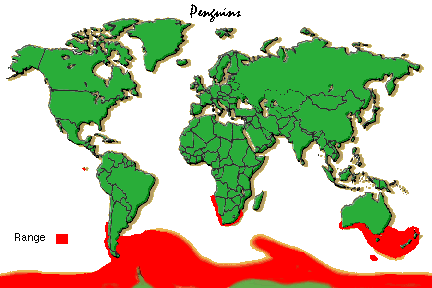 Like other bird species, they have very little (if any at all) sense of smell. They also have a very limited sense of taste which would explain their diet of mainly fish! Unlike of birds, they do not migrate in the winter to warmer weather. They prefer the icy chill of the Antartic. When they court each other, like many other birds, each learns the others song so they can always tell their mate from anothers mate.
Like other bird species, they have very little (if any at all) sense of smell. They also have a very limited sense of taste which would explain their diet of mainly fish! Unlike of birds, they do not migrate in the winter to warmer weather. They prefer the icy chill of the Antartic. When they court each other, like many other birds, each learns the others song so they can always tell their mate from anothers mate.
The estimated number of Emperor Penguins is 350,000. They are found only in the southern hemisphere, spending their entire life in Antartica. They are the only known living species that reproduces in the Antartic during the winter, and with a success rate of over 75%! They also spend as much as 75% of their lives in the frigid water.
 Penguins are very social animals. They will gather, swim and feed in large groups. As many as 6000 males will gather when brooding to keep the eggs warm. Breeding colonies of over 100,000 have been recorded too.
Penguins are very social animals. They will gather, swim and feed in large groups. As many as 6000 males will gather when brooding to keep the eggs warm. Breeding colonies of over 100,000 have been recorded too.
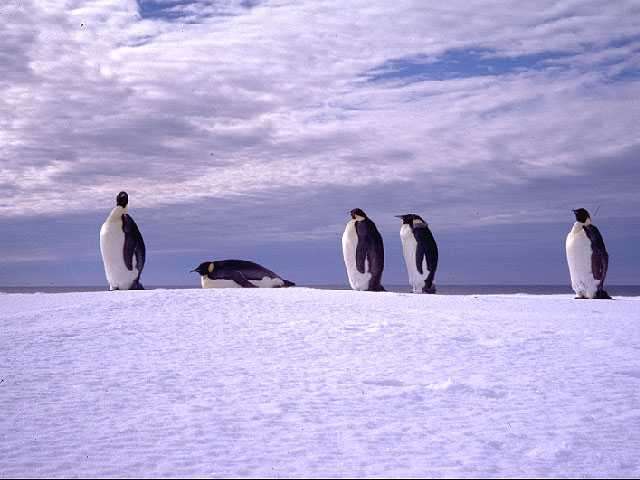 Because most of the land in the Antartic is ice and because Emperor penguins have paddle-like feet, walking on the ice is very ineffective. When forced to walk, it is very slow and awkward. Instead of walking, they use a method called toboganning where they slide on their bellies. They ise their flippers to push them, helping them to attain speeds of up to 1/2 a mile per hour. They have been known to travel over 50 miles using toboganning to reach the ocean.
Because most of the land in the Antartic is ice and because Emperor penguins have paddle-like feet, walking on the ice is very ineffective. When forced to walk, it is very slow and awkward. Instead of walking, they use a method called toboganning where they slide on their bellies. They ise their flippers to push them, helping them to attain speeds of up to 1/2 a mile per hour. They have been known to travel over 50 miles using toboganning to reach the ocean.
The black and white markings on their body help hide them from the view of their predators. Their most feared predator is the leopard seal.
The Emperor Penguins typical lifespan is around 20 years.
Links:
Great ideas for kids to learn about penguins!
| VISIT THE TIGERS | SEE THE SEA HORSES | DIVE WITH HAMMERHEADS |
| WATCH THE JAGUARS | SWIM WITH BLUE WHALES | EXPLORE THE AYE-AYE |
| THE EMPEROR PENGUINS | SPOT THE SPOTTED CUSCUS | FLY WITH THE BIRDS OF PARADISE |
| BULLY THE BULL SHARK | new animal soon!! | new animal soon!! |
| |||
|
|
All information was obtained from free sources on the web. If you see something that belongs to you then please let me know and I will credit you.
This page hosted by ![]() Get your own Free Home Page
Get your own Free Home Page